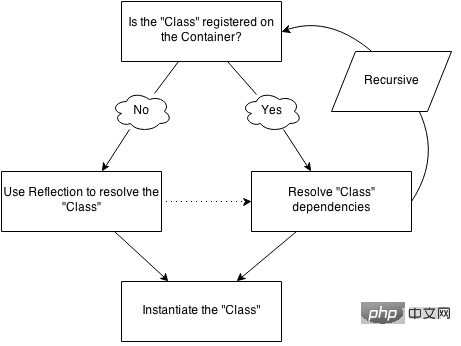Dependency injection and IoC in Laravel

#As developers, we are always trying to find new ways to write well-designed and robust code by using design patterns and trying new robust frameworks. In this article, we'll explore the Dependency Injection design pattern with Laravel's IoC components and see how it can improve our designs.
Dependency Injection
The term dependency injection is a term proposed by Martin Fowler, which is the act of injecting components into an application. As Ward Cunningham said:
Dependency injection is a key element in agile architecture.
Let's look at an example:
class UserProvider{
protected $connection;
public function __construct(){
$this->connection = new Connection;
}
public function retrieveByCredentials( array $credentials ){
$user = $this->connection
->where( 'email', $credentials['email'])
->where( 'password', $credentials['password'])
->first();
return $user;
}
}If you want to test or maintain this class, you must access the database instance to perform some queries. To avoid having to do this, you can decouple this class from other classes, you have one of three options to inject the Connection class without using it directly.
When injecting components into a class, you can use one of the following three options:
Constructor method injection
class UserProvider{
protected $connection;
public function __construct( Connection $con ){
$this->connection = $con;
}
...Setter method injection
Similarly, we can also use the Setter method to inject dependencies:
class UserProvider{
protected $connection;
public function __construct(){
...
}
public function setConnection( Connection $con ){
$this->connection = $con;
}
...Interface injection
interface ConnectionInjector{
public function injectConnection( Connection $con );
}
class UserProvider implements ConnectionInjector{
protected $connection;
public function __construct(){
...
}
public function injectConnection( Connection $con ){
$this->connection = $con;
}
}When a class implements our interface, we defineinjectConnection method to resolve dependencies.
Advantages
Now when testing our classes we can mock dependent classes and pass them as parameters. Each class must focus on a specific task and should not be concerned with resolving their dependencies. This way, you'll have a more focused and maintainable application.
If you want to learn more about DI, Alejandro Gervassio has covered it extensively and expertly in this series of articles, so be sure to read them. So, what is IoC? IoC (Inversion of Control) does not require the use of dependency injection, but it can help you manage dependencies effectively.
Inversion of Control
Ioc is a simple component that makes it easier to resolve dependencies. You can describe the object as a container, and every time a class is resolved, dependencies are automatically injected.
Laravel Ioc
Laravel Ioc is a little special in the way it resolves dependencies when you request an object:

We use A simple example will improve it in this article. The SimpleAuth class depends on FileSessionStorage, so our code might look like this:
class FileSessionStorage{
public function __construct(){
session_start();
}
public function get( $key ){
return $_SESSION[$key];
}
public function set( $key, $value ){
$_SESSION[$key] = $value;
}
}
class SimpleAuth{
protected $session;
public function __construct(){
$this->session = new FileSessionStorage;
}
}
//创建一个 SimpleAuth
$auth = new SimpleAuth();This is a classic approach, let's start with using the constructor Function injection begins.
class SimpleAuth{
protected $session;
public function __construct( FileSessionStorage $session ){
$this->session = $session;
}
}Now we create an object:
$auth = new SimpleAuth( new FileSessionStorage() );
Now I want to use Laravel Ioc to manage all this.
Because the Application class inherits from the Container class, you can access the container through the App facade.
App::bind( 'FileSessionStorage', function(){
return new FileSessionStorage;
});bind The first parameter of the method is the unique ID to be bound to the container, and the second parameter is a callback function that is executed whenever the FileSessionStorage class is executed. , we can also pass a string representing the class name as shown below.
Note: If you look at the Laravel package, you will see that bindings are sometimes grouped, such as ( view, view.finder ...).
Assuming we convert the session store to Mysql storage, our class should look like:
class MysqlSessionStorage{
public function __construct(){
//...
}
public function get($key){
// do something
}
public function set( $key, $value ){
// do something
}
} Now that we have changed the dependencies, we also need to change the SimpleAuth construct function and bind the new object to the container!
High-level modules should not depend on low-level modules, both should depend on abstract objects.
Abstraction should not depend on details, details should depend on abstraction.Robert C. Martin
Our SimpleAuth class should not care about how our storage is done, instead it should focus more on consuming the service.
Therefore, we can abstractly implement our storage:
interface SessionStorage{
public function get( $key );
public function set( $key, $value );
} so that we can implement and request an instance of the SessionStorage interface:
class FileSessionStorage implements SessionStorage{
public function __construct(){
//...
}
public function get( $key ){
//...
}
public function set( $key, $value ){
//...
}
}
class MysqlSessionStorage implements SessionStorage{
public function __construct(){
//...
}
public function get( $key ){
//...
}
public function set( $key, $value ){
//...
}
}
class SimpleAuth{
protected $session;
public function __construct( SessionStorage $session ){
$this->session = $session;
}
}If we Use App::make('SimpleAuth') to resolve the SimpleAuth
class through the container, the container will throw BindingResolutionException trying to resolve the class from the binding After that, go back to the reflection method and resolve all dependencies.
Uncaught exception 'Illuminate\Container\BindingResolutionException' with message 'Target [SessionStorage] is not instantiable.'
The container is trying to instantiate the interface. We can make a specific binding for this interface.
App:bind( 'SessionStorage', 'MysqlSessionStorage' );
现在每次我们尝试从容器解析该接口时,我们会得到一个 MysqlSessionStorage 实例。如果我们想要切换我们的存储服务,我们只要变更一下这个绑定。
Note: 如果你想要查看一个类是否已经在容器中被绑定,你可以使用 App::bound('ClassName') ,或者可以使用 App::bindIf('ClassName') 来注册一个还未被注册过的绑定。
Laravel Ioc 也提供 App::singleton('ClassName', 'resolver') 来处理单例的绑定。
你也可以使用 App::instance('ClassName', 'instance') 来创建单例的绑定。
如果容器不能解析依赖项就会抛出 ReflectionException ,但是我们可以使用 App::resolvingAny(Closure) 方法以回调函数的形式来解析任何指定的类型。
Note: 如果你为某个类型已经注册了一个解析方式 resolvingAny 方法仍然会被调用,但它会直接返回 bind 方法的返回值。
小贴士
- 这些绑定写在哪儿:
如果只是一个小型应用你可以写在一个全局的起始文件global/start.php中,但如果项目变得越来越庞大就有必要使用 Service Provider 。 - 测试:
当需要快速简易的测试可以考虑使用php artisan tinker,它十分强大,且能帮你提升你的 Laravel 测试流程。 - Reflection API:
PHP 的 Reflection API 是非常强大的,如果你想要深入 Laravel Ioc 你需要熟悉 Reflection API ,可以先看下这个 教程 来获得更多的信息。
最后
和往常一样,学习或者了解某些东西最好的方法就是查看源代码。Laravel Ioc 仅仅只是一个文件,不会花费你太多时间来完成所有功能。你想了解更多关于 Laravel Ioc 或者 Ioc 的一般情况吗?那请告诉我们吧!
推荐教程:《Laravel教程》
The above is the detailed content of Dependency injection and IoC in Laravel. For more information, please follow other related articles on the PHP Chinese website!

Hot AI Tools

Undresser.AI Undress
AI-powered app for creating realistic nude photos

AI Clothes Remover
Online AI tool for removing clothes from photos.

Undress AI Tool
Undress images for free

Clothoff.io
AI clothes remover

AI Hentai Generator
Generate AI Hentai for free.

Hot Article

Hot Tools

Notepad++7.3.1
Easy-to-use and free code editor

SublimeText3 Chinese version
Chinese version, very easy to use

Zend Studio 13.0.1
Powerful PHP integrated development environment

Dreamweaver CS6
Visual web development tools

SublimeText3 Mac version
God-level code editing software (SublimeText3)

Hot Topics
 PHP vs. Flutter: The best choice for mobile development
May 06, 2024 pm 10:45 PM
PHP vs. Flutter: The best choice for mobile development
May 06, 2024 pm 10:45 PM
PHP and Flutter are popular technologies for mobile development. Flutter excels in cross-platform capabilities, performance and user interface, and is suitable for applications that require high performance, cross-platform and customized UI. PHP is suitable for server-side applications with lower performance and not cross-platform.
 How to use object-relational mapping (ORM) in PHP to simplify database operations?
May 07, 2024 am 08:39 AM
How to use object-relational mapping (ORM) in PHP to simplify database operations?
May 07, 2024 am 08:39 AM
Database operations in PHP are simplified using ORM, which maps objects into relational databases. EloquentORM in Laravel allows you to interact with the database using object-oriented syntax. You can use ORM by defining model classes, using Eloquent methods, or building a blog system in practice.
 Analysis of the advantages and disadvantages of PHP unit testing tools
May 06, 2024 pm 10:51 PM
Analysis of the advantages and disadvantages of PHP unit testing tools
May 06, 2024 pm 10:51 PM
PHP unit testing tool analysis: PHPUnit: suitable for large projects, provides comprehensive functionality and is easy to install, but may be verbose and slow. PHPUnitWrapper: suitable for small projects, easy to use, optimized for Lumen/Laravel, but has limited functionality, does not provide code coverage analysis, and has limited community support.
 Laravel - Artisan Commands
Aug 27, 2024 am 10:51 AM
Laravel - Artisan Commands
Aug 27, 2024 am 10:51 AM
Laravel - Artisan Commands - Laravel 5.7 comes with new way of treating and testing new commands. It includes a new feature of testing artisan commands and the demonstration is mentioned below ?
 Comparison of the latest versions of Laravel and CodeIgniter
Jun 05, 2024 pm 05:29 PM
Comparison of the latest versions of Laravel and CodeIgniter
Jun 05, 2024 pm 05:29 PM
The latest versions of Laravel 9 and CodeIgniter 4 provide updated features and improvements. Laravel9 adopts MVC architecture and provides functions such as database migration, authentication and template engine. CodeIgniter4 uses HMVC architecture to provide routing, ORM and caching. In terms of performance, Laravel9's service provider-based design pattern and CodeIgniter4's lightweight framework give it excellent performance. In practical applications, Laravel9 is suitable for complex projects that require flexibility and powerful functions, while CodeIgniter4 is suitable for rapid development and small applications.
 How do the data processing capabilities in Laravel and CodeIgniter compare?
Jun 01, 2024 pm 01:34 PM
How do the data processing capabilities in Laravel and CodeIgniter compare?
Jun 01, 2024 pm 01:34 PM
Compare the data processing capabilities of Laravel and CodeIgniter: ORM: Laravel uses EloquentORM, which provides class-object relational mapping, while CodeIgniter uses ActiveRecord to represent the database model as a subclass of PHP classes. Query builder: Laravel has a flexible chained query API, while CodeIgniter’s query builder is simpler and array-based. Data validation: Laravel provides a Validator class that supports custom validation rules, while CodeIgniter has less built-in validation functions and requires manual coding of custom rules. Practical case: User registration example shows Lar
 PHP code unit testing and integration testing
May 07, 2024 am 08:00 AM
PHP code unit testing and integration testing
May 07, 2024 am 08:00 AM
PHP Unit and Integration Testing Guide Unit Testing: Focus on a single unit of code or function and use PHPUnit to create test case classes for verification. Integration testing: Pay attention to how multiple code units work together, and use PHPUnit's setUp() and tearDown() methods to set up and clean up the test environment. Practical case: Use PHPUnit to perform unit and integration testing in Laravel applications, including creating databases, starting servers, and writing test code.
 Which one is more beginner-friendly, Laravel or CodeIgniter?
Jun 05, 2024 pm 07:50 PM
Which one is more beginner-friendly, Laravel or CodeIgniter?
Jun 05, 2024 pm 07:50 PM
For beginners, CodeIgniter has a gentler learning curve and fewer features, but covers basic needs. Laravel offers a wider feature set but has a slightly steeper learning curve. In terms of performance, both Laravel and CodeIgniter perform well. Laravel has more extensive documentation and active community support, while CodeIgniter is simpler, lightweight, and has strong security features. In the practical case of building a blogging application, Laravel's EloquentORM simplifies data manipulation, while CodeIgniter requires more manual configuration.






